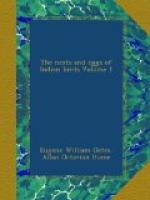Mr. J. Darling, jun., writes from the Nilghiris:—“I have found the nest of this Crow pretty nearly all over the Nilghiris. The usual number of eggs laid is four, but on one occasion, near the Quinine Laboratory in the Government Gardens at Ooty, I procured six from one nest. The breeding-season is from March to May, but I have taken eggs as early as the 12th February.”
From Ceylon, we hear from Mr. Layard that “about the villages the Carrion-Crow builds its nest in the cocoanut-trees. In the jungles it selects a tall tree, amid the upper branches of which it fixes a framework of sticks, and on this constructs a nest of twigs and grasses. The eggs, from three to five, are usually of a dull greenish-brown colour, thickly mottled with brown, these markings being most prevalent at the small end. They are usually laid in January and February.”
Mr. J.E. Cripps informs us that in Eastern Bengal it is “common and a permanent resident. Occasionally found in the clumps of jungle that are found about the country, which the next species never affects. Breeds in the cold weather. I had noticed a pair building on a Casuarina tree in my garden, about 50 feet off the ground, and on the 18th December, 1877, I took two perfectly fresh eggs from it; and again on the 9th January, 1878, I found two callow young in this same nest, the birds never having deserted it. The lining used for this nest was principally jute-fibre—any tree is selected to build on; the nests are placed from 15 to 50 feet off the ground. Some nests are very well concealed, whereas others are quite exposed. On the 15th January I found a nest about 15 feet up a small kudum tree, standing in a large plain, and which had a lining of hair from the tail-tufts of cows. There was one fresh egg, and a week later I got another fresh egg from this very nest. From two to four eggs are in each nest.”
Mr. Oates writes from Pegu:—“These birds all begin to build about the same time, and I have taken numerous nests at the end of January. At the end of February most nests contain young birds.”
Mr. W. Theobald gives the following notes on the nidification of this bird in Tenasserim and near Deoghur:—
“Lays in the third week of February and fourth week of March: eggs ovato-pyriform; size 1.66 by 1.15; colour, dull sap-green much blotched with brown; nest carefully placed in tall trees.”
The eggs, though smaller, closely resemble, as might have been expected, those of the Raven, but they are, I think, typically somewhat broader and shorter. Almost every variety, as far as coloration goes, to be found amongst those of the Raven, are found amongst the eggs of the present species, and vice versa; and for a description of these it is only necessary to refer to the account of the former species; but I may notice that amongst the eggs of C. macrorhynchus I have not yet noticed any so boldly blotched as is occasionally the case with some of the eggs of the




